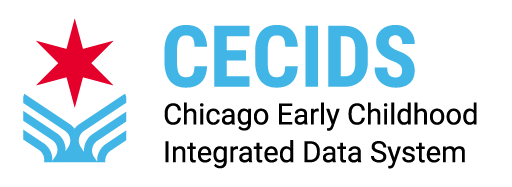The CECIDS model estimates the number of children eligible for the following major subsidized early child care programs In Chicago based on each Program’s published eligibility requirements related to child age, household income, and/or household labor force participation.
- Early Head Start: Children of infant or toddler age (0 to 3 years on or by September 1) with household incomes equal to or below the federal poverty line are eligible to be served by the Early Head Start program.
- Head Start: Children of preschool age (3 years on or by September 1 to kindergarten) with household incomes equal to or below the federal poverty line are eligible to be served by the Head Start program.
- Preschool For All (PFA): Among the priority populations for the Preschool For All program are children whose family income is less than 4 times the poverty guidelines published by the U.S. Department of Health and Human Services. Accordingly, the eligibility requirement for PFA in the model is children between the ages of 3 to 5 years (who are not yet in kindergarten) from households with gross incomes less than 400 percent or the federal poverty level (FPL).
- Prevention Initiative Program (Pl): Children between the ages of 0 to 3 years from households with gross incomes less than 400 percent of the federal poverty level (FPL). The rationale for this Income threshold for eligibility is described above.
- Public preschool (Chicago Public Schools): Children who turn 3 to 4 years old on or before September 1 and who reside within the elementary school attendance boundary of a Chicago Public Schools (CPS) pre-K program are eligible to be served by public preschool.
- Child Care Assistance Program (CCAP)/State child care subsidy: Children between the ages of 0 to 5 years from households with gross incomes less than 225 percent of the federal poverty level (FPL) and which also meet the state’s approved activity requirements are eligible to receive CCAP subsidies.
Depending on their age, household income, household labor force participation, and location, children may be eligible for more than one subsidized early child care program. For example, a preschool-age child in a household with a combined income equal to the federal poverty level and in which all adults are in the labor force is eligible for both Head Start and CCAP.
Data Sources
- Child Care Assistance Program (CCAP) Policy Manual, Illinois Department of Human Services
- Head Start Early Childhood Learning and Knowledge Center, Head Start Performance Standards Part 1302 Subpart A
- Illinois Prevention Initiative Implementation Manual (2013), Illinois State Board of Education
- Preschool For all/Preschool For all Expansion, Implementation Manual, Illinois State Board of Education, March 2022
- US Census Bureau 2020 American Community Survey (ACS) summary tables B17024 and B23008, ACS Public Use Manual Sample (PUMS) household- and person-level files
- Records management systems used by each Data Governor: DFSS, Carole Robertson Center, Chicago Commons, Henry Booth House, Easterseals and Start Early
- Chicago Public Schools (CPS)
- Illinois State Board of Education (ISBE)
- Department of Children and Family Services (DCFS)
- Illinois Department of Human Services (IDHS)
Assigning Served Children
Some program data explicitly indicate the distinct children they serve (e.g., data from Data Governor source systems and Chicago Public Schools). Data from other subsidized child care programs are aggregated and indicated only the number of children they serve at each provider site (e.g., CCAP enrollment data from IDHS).
Where data on children served by child care funding programs is available, the children served by that program are identified and added to the model’s child table along with the provider site where they receive child care services. Data from each Data Governor is incorporated into the model based on the last valid data submission by that Data Governor. Some Data Governors submit the data weekly, some monthly, and Chicago Public Schools submits semi-annually. In some cases, the model also infers the age, income, and household employment status of these served children from the eligibility requirements of the subsidized child care programs that serve them.
Where child-level data is not available from a subsidized child care program, the children served by that program must be assigned to providers that participate in that program. For this, the model extracts children from the child population data set that meet different programs’ specific age, family income, and family employment status requirements and assigns them to participating providers. The number of children that are assigned in this manner to a provider is determined by actual aggregate data on the number of children served by each subsidized program at a given provider site.
Program Overlap
Children may be simultaneously served by more than one subsidized child care program. For instance, a child served by state subsidy may also receive care from a Head Start provider.
For programs for which child-level data is available, it is possible to identify the distinct children that are served by each program at every participating provider site. It is also possible to specifically determine which children are served by more than one program.
For programs for which there is no child-level data, the model assigns numerical counts of children served (based on program eligibility rules) to different subsidized programs (and program combinations) at a given provider site. The children assigned in this manner to providers and programs are not uniquely identified. It is therefore not possible to determine whether the children that comprise these child counts are simultaneously served by another program at a different provider site.
Given this constraint, CECIDS specifically defines program overlap as instances in which a child is served by more than one child care funding program at the same provider site.
